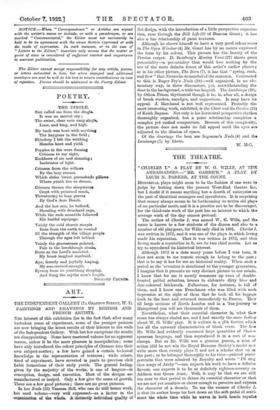ART.
..tHE TDEPENDENT GALLERY (7A Gnarro?.T Sxnurr, W. 1). PAINTINGS AND DRAWINGS BY BRITISH AND FRENCH ARTISTS.
THE interest of this exhibition lies in the fact that, after many turbulent years of experiment, some of the younger painters are now bringing the latest results of their labours to the walls of the Independent Gallery. With but few exceptions the results are disappointing. Some have mastered volume for no apparent reason, unless it be the mere pleasure in manipulation ; some have ably introduced the colour principles of Cezanne into their own subject-matter ; a few have gained a certain technical knowledge in the representation of textures ; while others, tired of experiment, have reverted in panic; to previous slick habit formations of their early youth. The general feeling, given by the majority of the worn, is one of languor—in conception, design, and execution. Most of the designs are manufactured or insipid. Only a few give the sense of growth. There are a few good pictures ; there are no great pictures.
In her Nude (33) Vanessa Bell, who can do still better work. has used volume—very well expressed—as a factor in the organization of the whole. A distinctly individual quality of flat design, with the introduction of a little perspective organiza- tion, runs through the Still Life (9) of Duncan Grant ; it has also a fine relationship of paint textures.
Although he shows himself to have a very good colour sense in The Open Window (4) Mr. Grant has by no means expressed the form by his colour. This picture has the beauty of the Persian carpet. D. Bomberg's Moving Vans (27) shows groat potentiality—a potentiality that would lose nothing by the use of the more definite forms of this artist's earlier phases ; as in his other picture, The Barn (7), it has that "spring, rush, and flow" that Nietzsche demanded of the sentence. Contrasted to this is Roger Pry's Nude (28)—well organized, in an ele- mentary way, in three dimensions, yet, notwithstanding the door in the background, a trifle too languid. The Landscape (29), by Othon Friesz, rhythmical though it be, is, after all, a design of brush strokes, smudges, and suggestions. It may have its appeaL J. Marchand is not well represented. Probably the most interesting work, exhibited, is the Chair and the Garden (31) of Keith Baynes. Not only is his horizontal perspective rhythm thoroughly organized, but a poise relationship completes a complex yet unified composition. Because of this complexity, the picture does not make its full appeal until the eyes are adjusted to the illusion of space.
W. McC.






































 Previous page
Previous page